
16 minute read
YOUR PRODUCTION
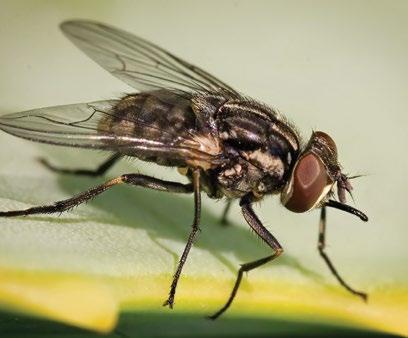

Advertisement
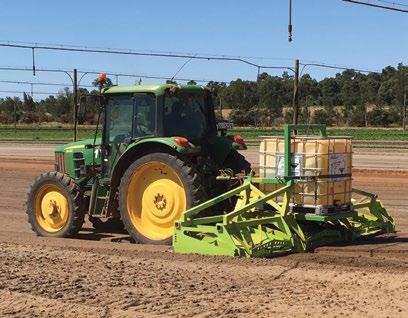
productionyour
f SUNN hemp in a mixed cover crop will soak up nitrogen in the soil and encourage the legume to add more.
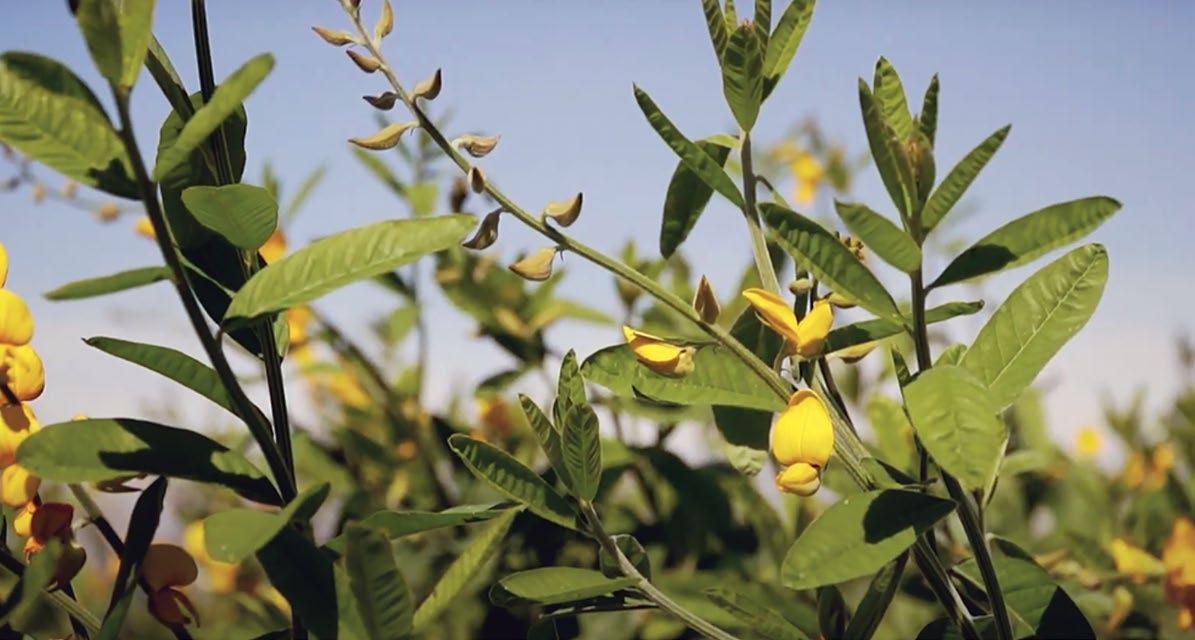
Nitrogen fertiliser price and supply:
A good reason to look at legume cover crops
BY SOIL WEALTH ICP TEAM
The Soil Wealth and Integrated Crop Protection (ICP) project works with growers to put soil management and plant health research into practice. This edition explores the use of legume cover crops to better manage nitrogen on-farm.
Soil Wealth ICP Phase 2 (VG16078) is a strategic levy investment under the Hort Innovation Vegetable Fund. The commercial nitrogen fertiliser market has been very volatile in recent times, with shipping issues and shortages for all of Australia. As Australia does not manufacture enough nitrogen to supply its own domestic market, the cost of nitrogen fertiliser has more than doubled. Given the price rises and uncertainty of nitrogen fertiliser supply, it’s a good time to add a legume cover crop into your rotation and reduce your reliance on nitrogen fertiliser. Legume cover crops can add lots of nitrogen, with a good cover crop adding 160–200 kilograms per hectare (kg/ha) of nitrogen. Based on current nitrogen fertiliser costs, that is $500–$600 of added nitrogen per hectare, with seed and inoculant costing around $100–$200 per hectare.
The science of biomass
To add the most nitrogen, legume biomass is king. For every tonne of shoot biomass grown, about 20kg of nitrogen will be added. So, if you can grow a good legume cover crop with the right inoculant and produce 8-10 tonnes of shoot biomass, then that’s 160–200kg of nitrogen added.
Your cover crop roots can have a further 30–100kg of nitrogen. Less nitrogen will be added when cover crops are grown as part of a cover crop mix, as the legume growth and biomass are reduced due to competition from the other cover crop species in the mixture. However, cover crop Add a legume cover crop and reduce your reliance on nitrogen fertiliser. mixes are a good option when you have high soil nitrate levels. High soil nitrate levels will reduce nitrogen added by legumes. Basically, if the plant can get lots of ‘free’ nitrogen from the soil, then it will not allow the Rhizobium bacteria to nodulate the roots and will not feed the bacteria. Instead, the plant will take the ‘free’ nitrogen from the soil. It’s important to use soil tests before your cover crop is planted to find out how much soil nitrate is remaining.
Additional resources can be found at soilwealth. com.au/resources
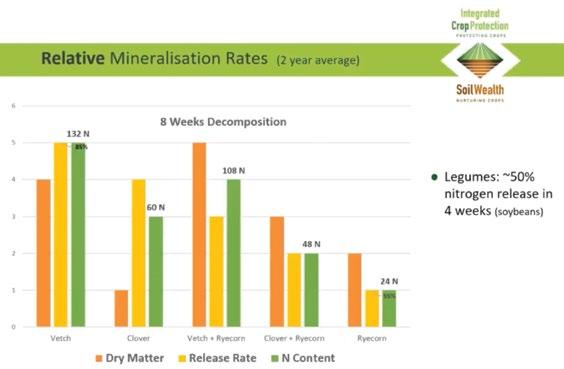
f MANAGING nitrogen on-farm and using legume cover crops webinar.
If it’s below 50kg of nitrogen per ha (to 30cm), the legumes will add lots of nitrogen. Above 200kg of nitrogen per ha will limit your legume from adding much nitrogen.
Managing soil nitrogen levels
Typically, soil nitrogen levels will be low following nitrogen-hungry crops like corn and potatoes; higher soil nitrogen levels are likely following leafy vegetable crops. The levels of soil nitrogen before you sow your cover crop will also depend on how much in-crop nitrogen fertiliser was used.
If you have high soil nitrogen levels, it may be better to plant a mixed cover crop of a cereal/ broadleaf and legume.
The cereal and broadleaf will recover and store the nitrogen in the soil and force the legume to fix its own nitrogen. A mix like a sunn hemp, sorghum and tillage radish for summer — or oats and vetch mix for winter — will do a good job of soaking up the nitrogen already in your soil left over from a previous crop and encourage the legumes in the mix to add some more nitrogen. Nitrogen added by legume cover crops must be converted into nitrate and ammonia by the soil biology to be available to your vegetable crop. This typically means there is a nice, slow release of nitrogen over the life of the crop.
Additional resources
To understand how much and when nitrogen will be available for your vegetable crop, watch the Soil Biology Master Class 2021 — Nitrogen availability webinar:
soilwealth.com.au/resources/ webinar-recordings/soil-biologymaster-class-2021-nitrogenavailability-day-1-part-3-of-7/
To help choose the right legume and Rhizobium, see the Cover Crops for Australian Vegetable Growers poster:
soilwealth.com.au/resources/ posters/cover-crops-foraustralian-vegetable-growers
You can also find out more about managing nitrogen on-farm and using legume cover crops in this recent webinar recording with Kelvin Montagu, Doris Blaesing and Marc Hinderager:
soilwealth.com.au/ resources/webinar-recordings/ nitrogen-fertiliser-price-andsupply-management-options-indifficult-conditions/
The presentation also covers: • Optimising fertiliser practices • Reducing nitrogen fertiliser losses (e.g., leaching and denitrification) • Soil testing and crop monitoring • An agronomist panel which discusses the strategies they have tried to manage nitrogen on their client's vegetable farms.
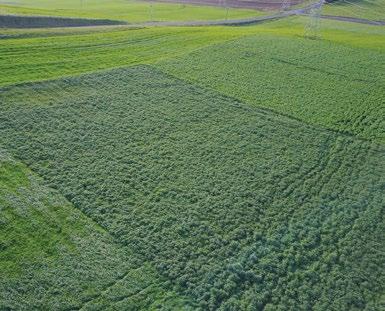
TIPS TO GET THE MOST NITROGEN OUT OF YOUR LEGUME COVER CROP
• Add the right Rhizobium inoculant at the right time • Select and grow a vigorous legume cover crop — the more biomass grown; the more nitrogen added • Grow a straight legume (i.e., not part of a cover crop mix) • Start with low to moderate soil nitrate levels — less than 50kg/ha of soil nitrate will encourage your legumes to add the most nitrogen.
MORE INFORMATION
For more information, please contact project leaders Dr Gordon Rogers on (02) 8627 1040 or gordon@ahr.com.au and Dr Anne-Maree Boland on (03) 9882 2670 or
anne-mareeb@rmcg.com.au

This project has been funded by Hort Innovation using the vegetable research and development levy and funds from the Australian Government.
Project Number: VG16078
For more information on the fund and strategic levy investment visit horticulture.com.au
Fall armyworm is a significant threat to horticultural production globally. Fall armyworm management guide for vegetable crops
f DARK head with Y-shaped light marking on FAW larvae.
KEY POINTS
• Fall armyworm (FAW) is a significant threat to horticultural production globally, and is now a threat to Australian horticulture.
• FAW was first detected in
Australia in January 2020 and has since travelled from the
Torres Strait to Tasmania in just 14 months.
• An integrated pest management program is key to controlling
FAW populations. Field monitoring is important for early detection and implementation of control methods.
• There are several insecticides that are available to control FAW in Australia.
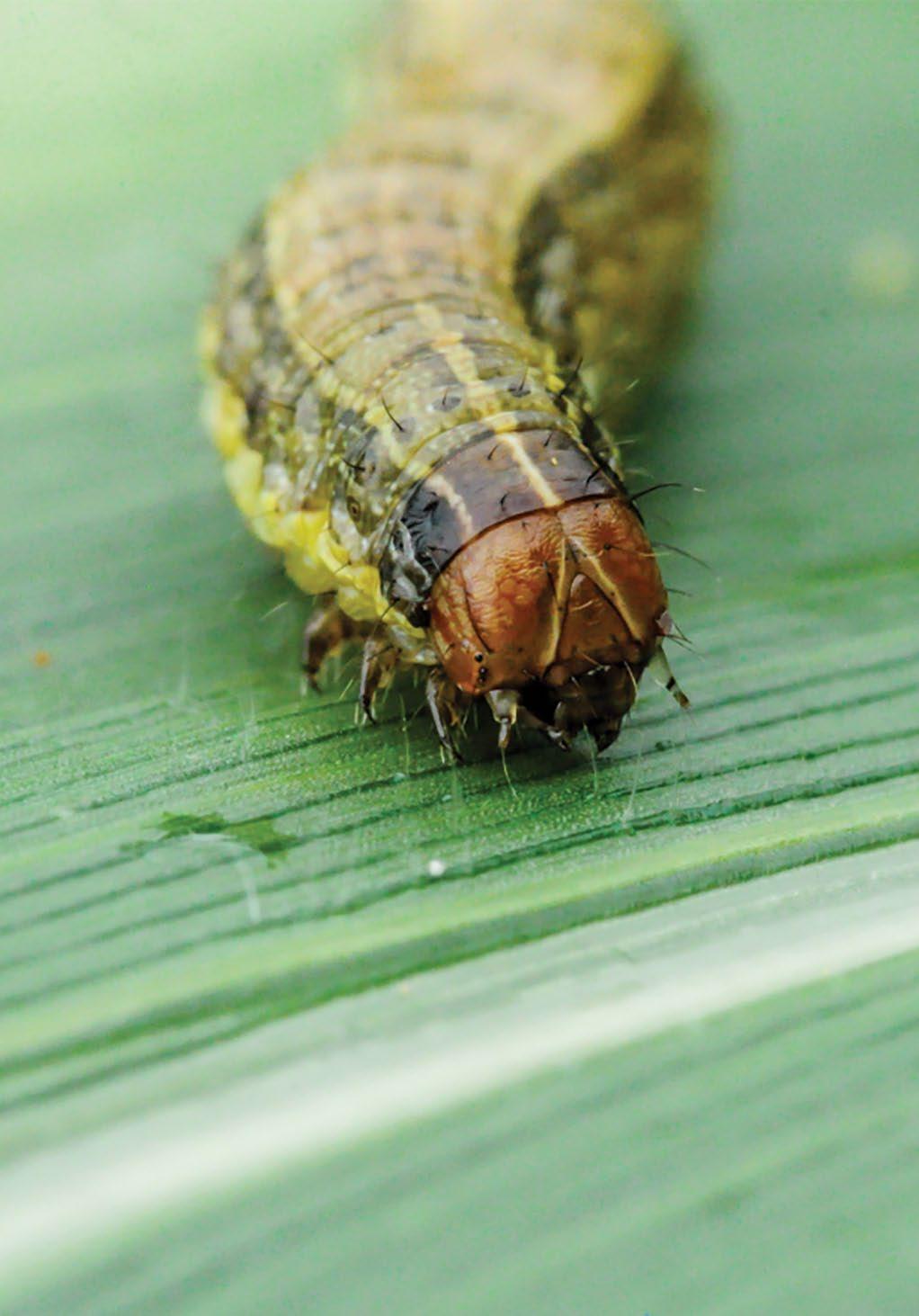
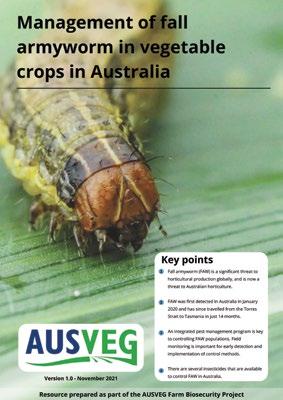
BY ZALI MAHONY BIOSECURITY OFFICER, AUSVEG
Amanagement guide for fall armyworm has recently been developed by AUSVEG, with assistance from the Department of Agriculture and Fisheries, Queensland. The guide is now available to growers and industry in an online and hard copy format. AUSVEG Biosecurity Officer Zali Mahony reports.
Fall armyworm (FAW) is a significant threat to horticultural production globally and is now posing a risk to Australian horticulture. A destructive pest that attacks more than 350 plant species overseas, fall armyworm was first detected in Australia in January 2020 and travelled from the Torres Strait to Tasmania in just 14 months.
What to look out for
FAW larvae look similar to other armyworms present in Australia. However, there are two distinguishing features of FAW larvae that can be used for identification: 1 Four dark spots at the end of their body arranged in a square. 2 Dark head with an upside down, pale
Y-shaped marking.
Integrated pest management approach
The key to efficient control of FAW is an integrated pest management (IPM) program, inclusive of an artillery of sustainable practices. Cultural farm practices, biological control or conservation of natural enemies — as well as biopesticides and conventional insecticide applications — offer opportunities for future management of FAW.
Although there are chemicals that are available for control of FAW, the pest is known to quickly develop insecticide resistance to certain chemical groups. For example, evidence collected from Western Australia claims that FAW populations are resistant to group 1A (Carbamates) and 1B (Organophosphates) insecticides. Viable biological control options for FAW populations in Australia are currently being studied; however, research is in its early stages.
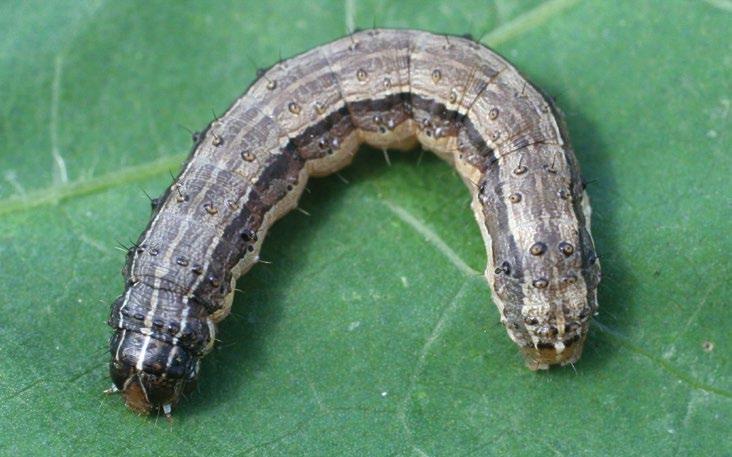
PRE-2016
2016 2018
2017 2019
2020
FIGURE 1. WORLDWIDE DISTRIBUTION: FAW IS A PEST NATIVE TO TROPICAL AND SUB-TROPICAL REGIONS OF THE AMERICAS, BUT HAS NOW SPREAD WORLDWIDE.
Monitor your crops regularly
Early detection of FAW ensures a quick response and accurate timing of control methods. Regular crop surveillance and monitoring for FAW eggs and larvae is the foundation of a successful IPM program and helps minimise damage and reduce harvest losses.
f FOUR raised spots in a square at the rear. For more information on chemicals available to control FAW, biological control options and crop monitoring techniques, download a copy of ‘Management of fall armyworm in vegetable crops in Australia’: (ausveg. com.au/app/uploads/2021/12/Final-pdfstandard-faw-guide_compressed.pdf) or email Zali Mahony on the details below if you wish to receive a hard copy.
MORE INFORMATION
Please contact AUSVEG Biosecurity Officer Zali Mahony on (03) 9882 0277 or email science@ausveg.com.au. This article was originally published in the Vegetables Australia magazine.
BUGWOOD.ORG PHOTO © RUSS OTTENS, UNIVERSITY OF GEORGIA,
Quantitative microbial risk assessment
and food safety management
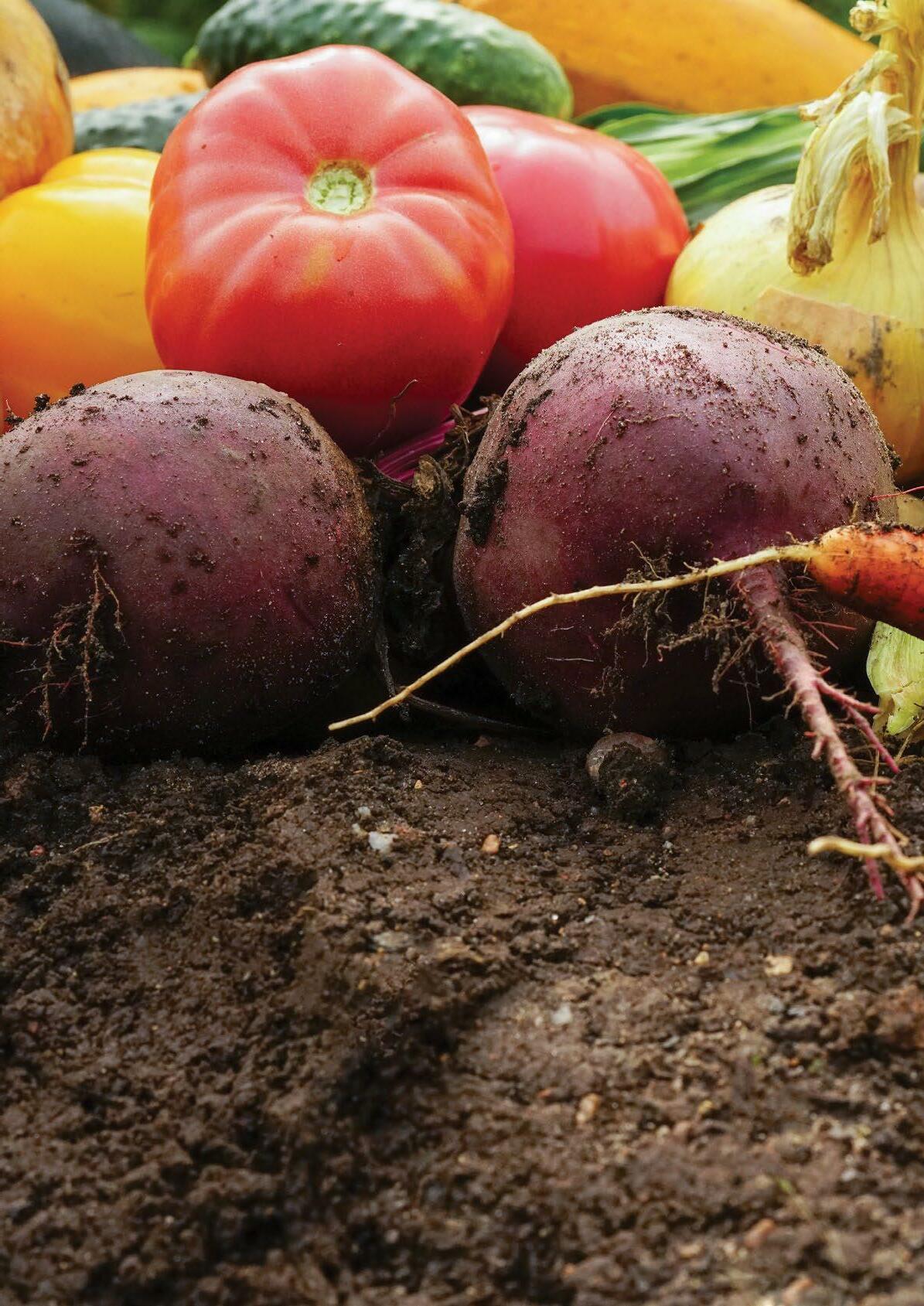
BY ELIZABETH FRANKISH FOOD SAFETY CONSULTANT, UNIVERSITY OF TASMANIA
Risk assessment is ‘science-based’, identifying the likelihood and severity of hazards, how those hazards interact with the food being produced, and the resulting level of risk to the consumer when the product is eaten.
Microbial risk assessment is especially complex because we are dealing with a community of live microorganisms, a fruit or vegetable both pre-harvest and postharvest i.e., live and ‘dead’, overlaid by climate, weather patterns and management systems. However, when undertaken with the best available knowledge and integrated into risk management decision-making, risk can be reduced.
There are many risk assessment approaches, and they are all valid. The best risk assessments are objective, transparent, consider the dynamics of microbial behaviour, account for uncertainties, and align the purpose of the assessment with the risk estimate output. In the modern food industry, where plant-based foods are taking centre stage, we cannot afford complacency about microbial hazard prevention and ongoing improvement in food safety.
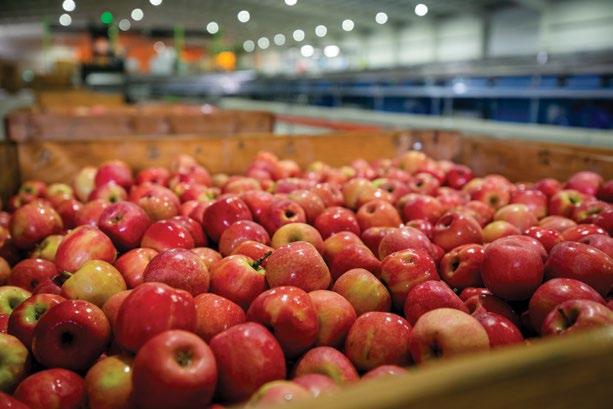
What is QMRA?
In quantitative microbial risk assessments, we attempt to determine how much and how quickly pathogens like Listeria monocytogenes or Salmonella will survive, grow, or die on produce under designated conditions. The output is an estimate of the probability of that survival, growth, or death occurring and how that influences public health outcomes. QMRA provides the ability to conduct ‘what if’ scenarios to investigate the effect of changes in supply chain factors. For example, “How many more pathogens would be destroyed if chlorine sanitiser in wash water was increased from 30ppm to 100ppm?” “How much is cross-contamination reduced if we wash equipment with a sanitiser between every batch of product?” “How important is temperature control of the product at retail?” It is also possible to determine how sensitive, or what is the relative importance of the input factors to the final risk level. This helps prioritise actions and changes in risk management because for example, it might be found there is more value in focusing on improving the washing process than implementing changes
Microbial risk assessment is especially complex.
to cold chain control. This supports decision making on the use of resources to reduce risk to the business and its customers.
How does QMRA help reduce food safety risks?
When people have a better understanding of risk, they understand why they should comply with procedures like handwashing and thorough equipment cleaning. This is important in ensuring consistent and sustained best practices within the food safety management system.
QMRA provides the evidence of what needs to change, why it should change, and the level of urgency for the change.
Thus, it provides a systematic approach to risk mitigation while supporting development of the food safety culture. Market forces, customer requirements, and regulatory requirements combine to drive imperatives to develop risk assessment processes. These mechanisms can be used to move from simple, qualitative risk assessment to more advanced quantitative risk assessment, at the cutting-edge of microbial control.
QMRA and risk reduction
What are the riskiest activities? How much is risk reduced by changing controls? Where are our resources best placed for risk mitigation?
What you should not expect from a QMRA
Often there are gaps in the available research data relating to a specific product, so QMRA is a combination of research data and expert opinion. This can require some estimates to be made of what is expected to occur. In these instances, practical experience and consultation among experts (growers, processors, scientists) lead to very good estimates which, with further research can be confirmed or disproved. When risk information is updated through QMRA the food safety management system must be able to support both the technical changes needed and the people who are responsible for implementing the changes, to ensure risk mitigation will be enhanced.
There is no magic bullet to always produce safe food, but what you can expect is that QMRA, by adding a sharper tool to the risk assessment kit, provides the knowledge for continuous improvement, the information to prioritise resources, and the evidence to support decision making.
MORE INFORMATION
Contact Elizabeth Frankish, Food Safety Consultant, Perth, Researcher, University of Tasmania: e: elizabeth.frankish@gmail.com e: elizabeth.frankish@utas.edu.au m: 0407 446 937
Elizabeth is currently working on a QMRA for the apple supply chain with funding and support from APAL (Apple and Pear Australia Ltd), University of Tasmania, and University of Sydney.
Pest and disease preparedness: How to protect your farm
BY ZALI MAHONY BIOSECURITY OFFICER, AUSVEG
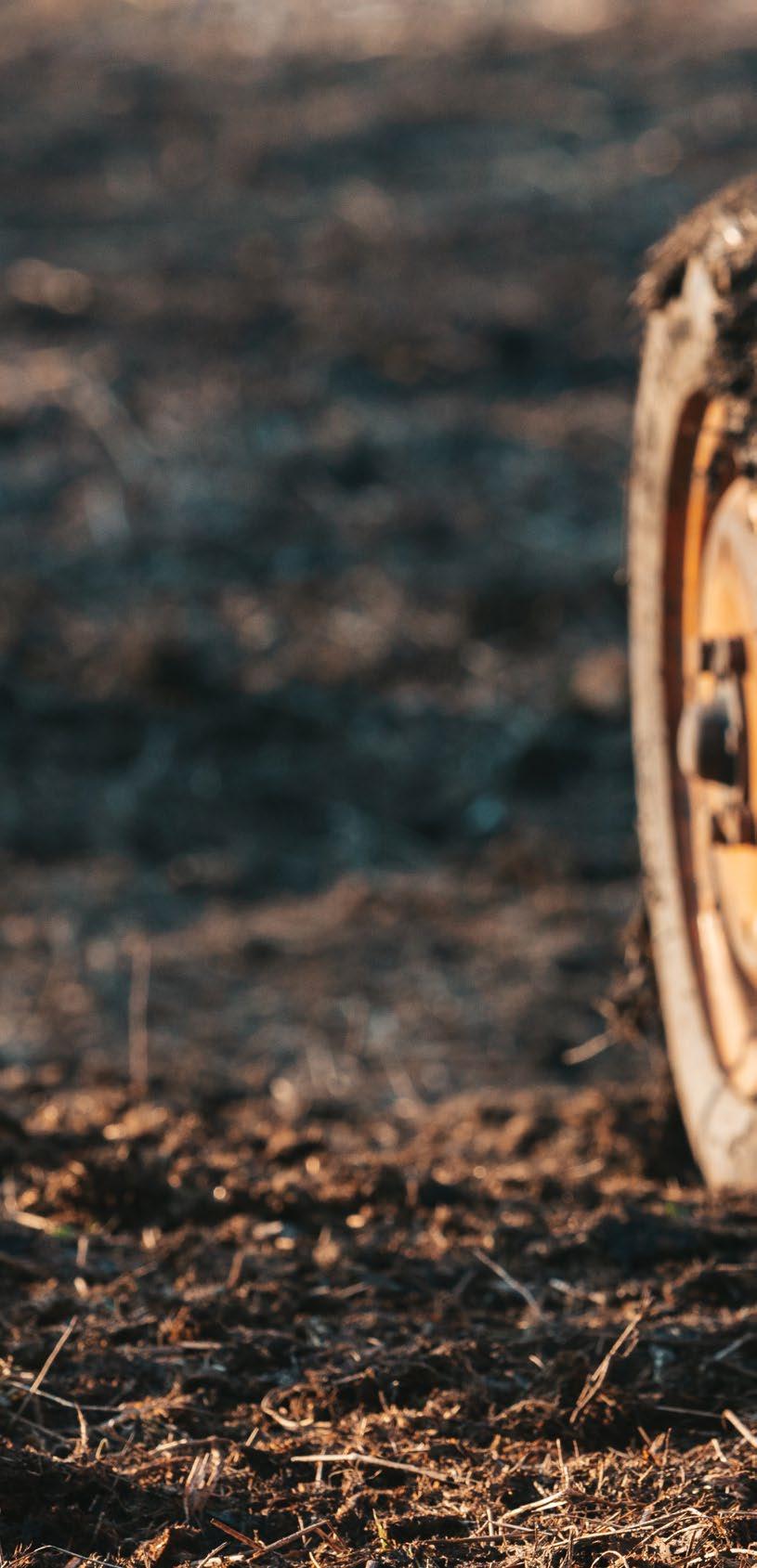
The best defence against harmful pests, diseases, viruses and weeds for your farm is to implement good farm hygiene. AUSVEG has recently developed a new management guide on how to protect and prepare your farm for pests and diseases.
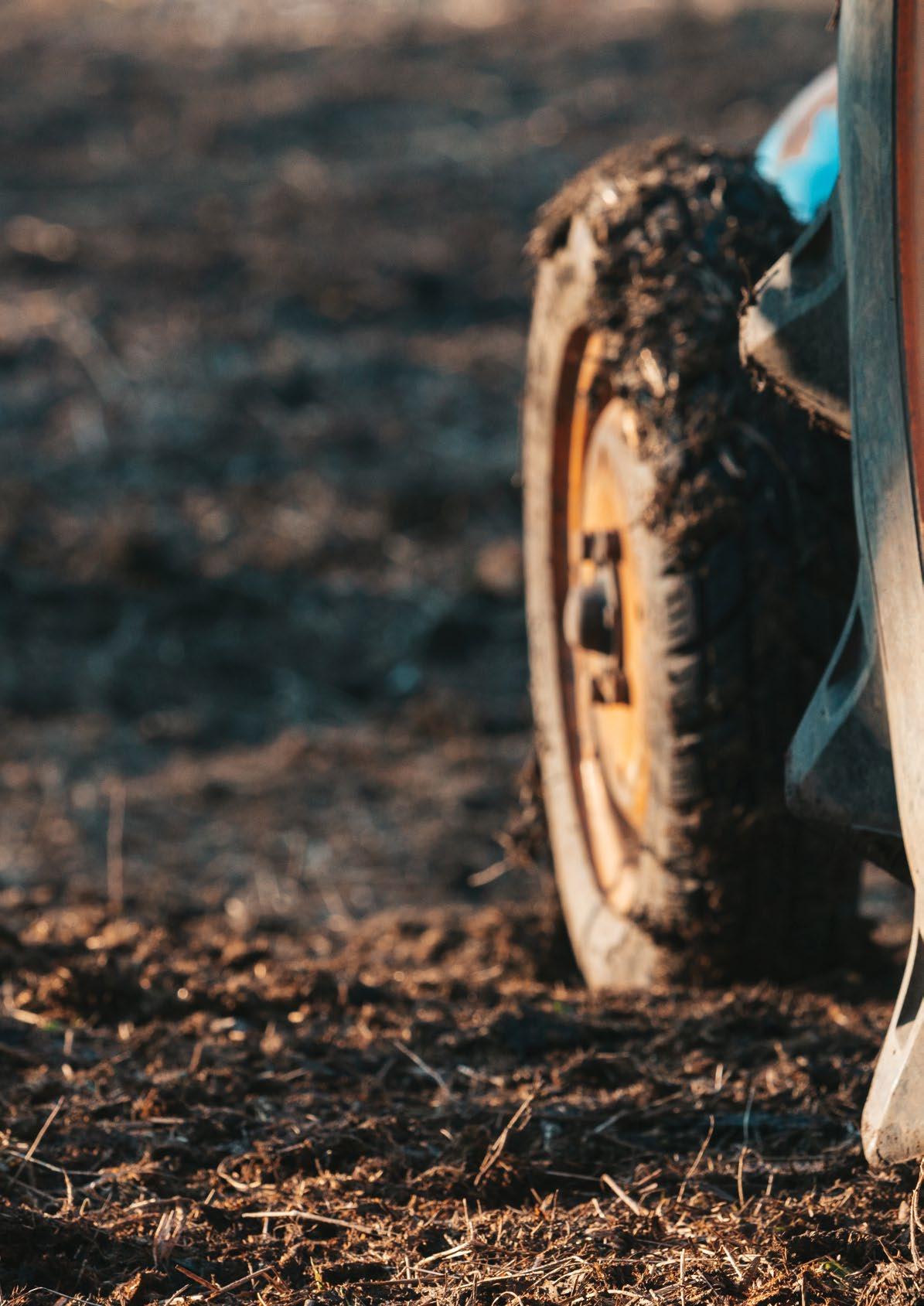
Farm biosecurity is the prevention and management of pests and diseases that are not yet present in a certain production area but are likely to arrive, either seasonally or through natural spread (e.g., wind). Good biosecurity practices can help you better manage these threats and also assist when faced with government-imposed farm quarantine or be used as evidence when applying for ‘pest free place of production’ accreditations.
Six main pathways for pest and disease spread
Use AUSVEG’s management guide to identify these pathways on your own property and see how you can start managing the risks. 1 Vehicles and equipment 2 Staff and farm visitors 3 Packaging, bins and pallets 4 Waste and weeds 5 Farm inputs 6 Wind.
The resource takes you through each pathway and discusses the risks involved. Where this guide differs from other resources is that it provides ways to manage, and reduce, the risks of each pathway.
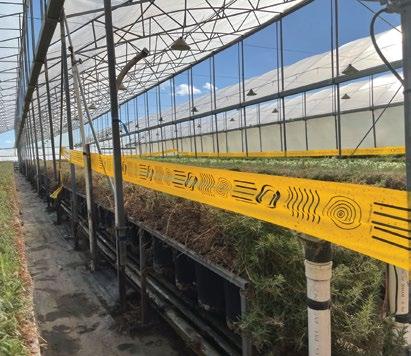
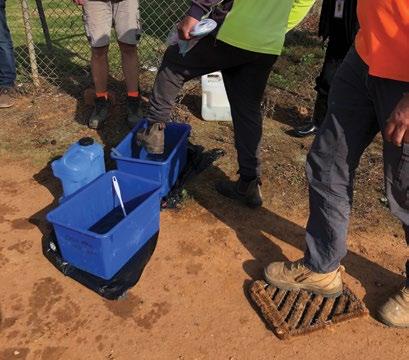
PHOTO © PLANT HEALTH AUSTRALIA PHOTO © AUSVEG
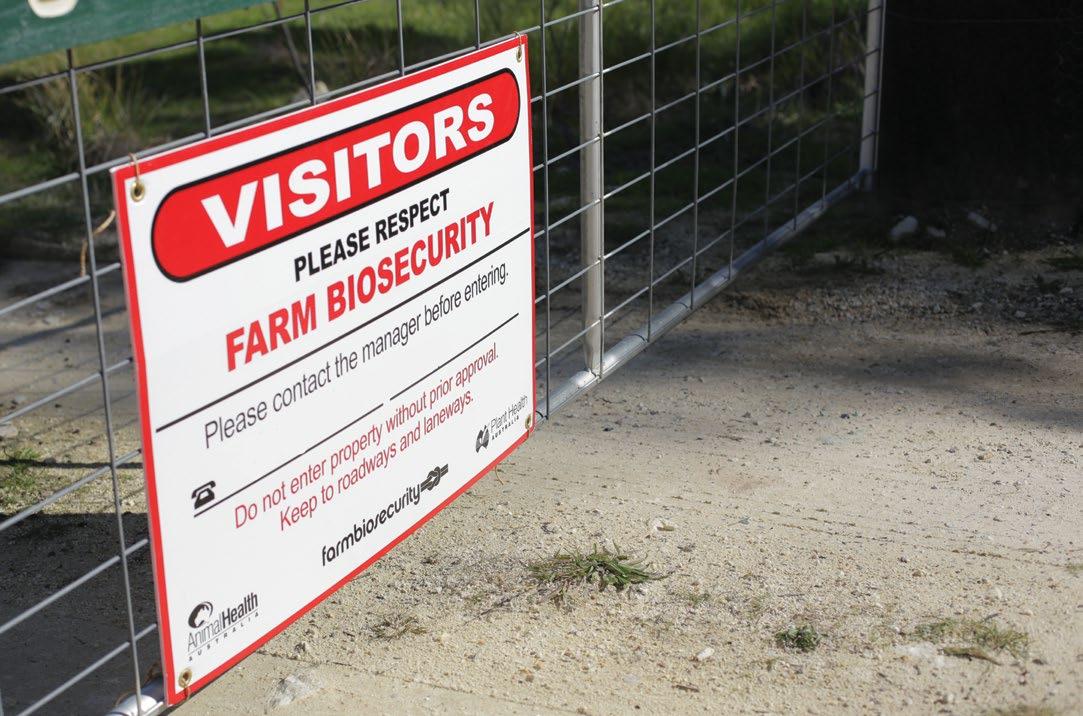
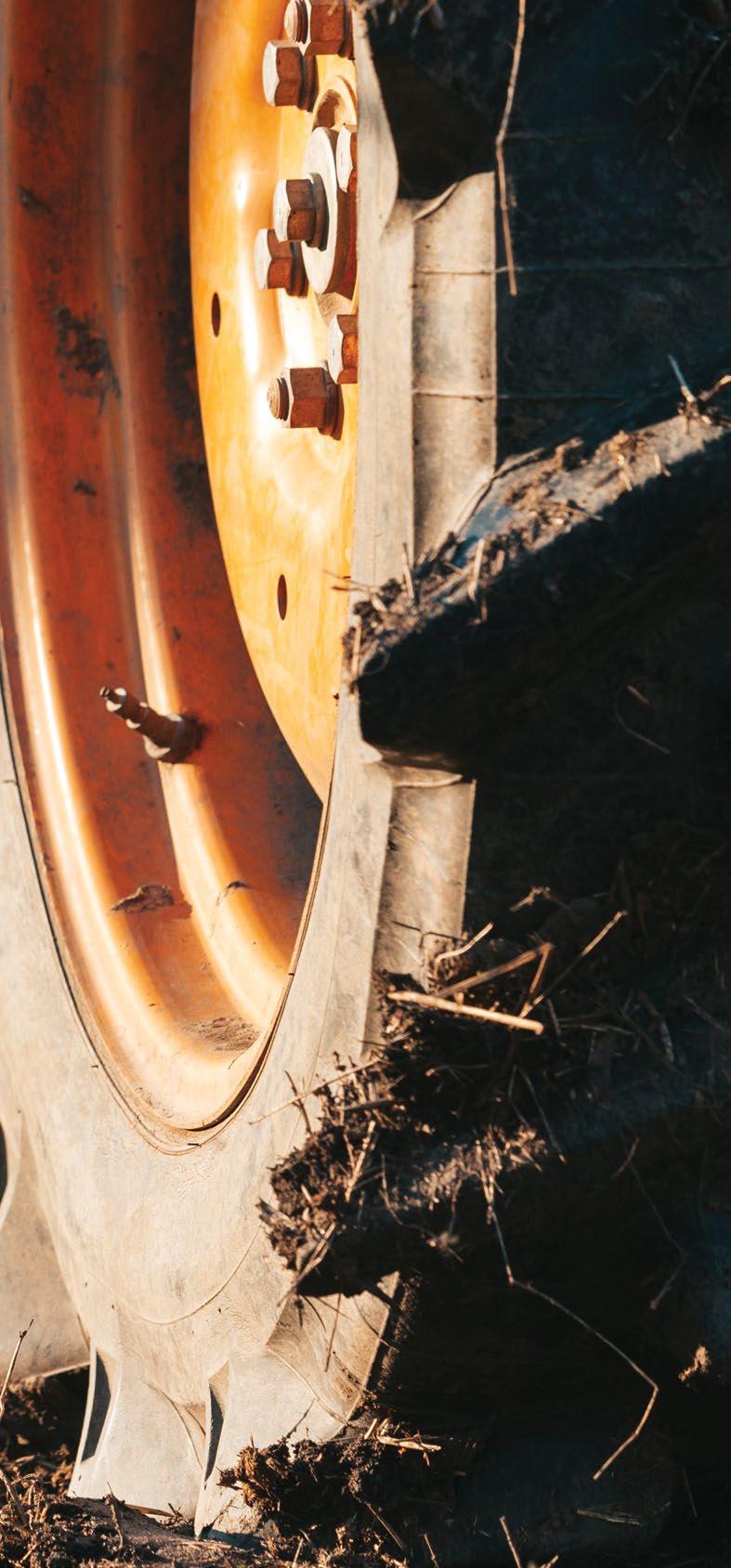
PHOTO © AUSVEG
Next steps
Once you have read the guide and are aware of the six high-risk pathways through which pests and diseases can spread onto farm, there are several actions you can take to ensure you are managing them appropriately for your farm, business, or property: • Review your farm’s current biosecurity measures and identify the pathways you are controlling well, and those that may require more management. • If there are certain pathways requiring more attention, use this booklet as a management guide. • If you are managing all pathways well, create a farm biosecurity plan for your property.
MORE INFORMATION
Please contact AUSVEG Biosecurity Officer Zali Mahony on (03) 9882 0277 or email science@ausveg.com.au. This article was originally published in the Vegetables Australia magazine.

Taking part in a field day?

BY RACHEL LANCASTER ENVIRONMENTAL AND AGRICULTURAL TESTING SERVICES
Field days are an excellent way to share information and knowledge. Don’t accidently also share pests and diseases by following some easy steps.
Pests, diseases and weeds can be carried on: • People: footwear, clothing, skin, mobile devices and even your hair! • Plant products: fruit, leaves, stems, and roots. • Equipment: secateurs, harvest machinery, tractors. • Vehicles: tour buses, attendees’ cars, quad bikes. Movement of people, plants, products, equipment and vehicles between farms can present a biosecurity risk to the host property and to the properties of attendees when they return home.
If you are a HOST:
; Provide a biosecurity briefing about the actions you would like visitors to take, so that attendees know what you expect of them. This can be on the invite to the field day. ; Make sure good biosecurity practices are visible on your property. ; Keep a register of all attendees to ensure tracing is possible if required. ; Ensure that you have a designated and clearly sign posted parking area. ; Provide a footwear wash and disinfection station at the point of entry e.g., boot scrubbers and water for cleaning, sanitising spray or a footbath containing an appropriate sanitising product for disinfestation. ; Consider providing ‘boot covers’ for all participants to wear, in case removal of soil from boots is difficult between farms. ; Provide hand sanitiser if people will be touching plants or soil. ; Avoid use of other people’s tools and equipment for demonstrations, unless they have been thoroughly cleaned and disinfected first. ; Monitor the part of your property where the visit took place over time for unfamiliar pests, pathogens or weeds.
f MOVEMENT of people, plants, products, equipment and vehicles between farms can present a biosecurity risk.
If you are an ATTENDEE:
; Make sure your clothing, footwear and vehicle are clean before attending the host property. Avoid wearing the usual clothes and shoes that you wear on your own farm. ; Clean and disinfect your footwear between each site during the field day and before returning to your own farm. ; Follow all biosecurity signage and requests at the host property. Be a biosecurity champion and help protect your farm and industry from pests and disease.
MORE INFORMATION
This article has been prepared by the Horticulture Liaison Officer Biosecurity Project, which is jointly funded by DPIRD, Agricultural Produce Commission (APC), Pomewest, Stonefruit WA, Carnarvon Banana Producers Committee and WA Citrus.




